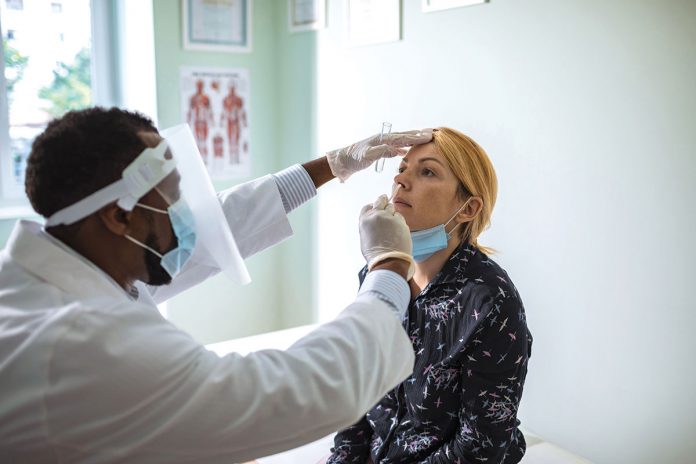Latina leaders in San Diego County shared their thoughts on how the COVID-19 pandemic affects the Latino population after reviewing statistics released by SANDAG showing the pandemic exacerbates ongoing disparities within the Latino and Hispanic population.
At the press conference on Dec. 15, Dr. Inez Gonzales Perezchica, MANA de San Diego executive director, said the effects of the pandemic are not just health-related.
“Small businesses are closing their doors and thousands here in San Diego County have lost their jobs and wages,” said. “The unemployment rate has risen sharply, especially among Latinas. With Latinos facing lost jobs and wages, we have seen local families unable to pay their bills and using their credit cards to buy food. Even before the pandemic, Latinos were concerned about their economic situation.”
Mayor Mary Casillas Salas, a representative of the SANDAG board of directors, said the statistics presented by SANDAG were startling.
• There are more than half a million (552,107) Latinas in the San Diego region, representing 17 percent of the population
• 70 percent of Hispanic residents lived in ZIP codes with higher than average unemployment rates
• 49 percent of Hispanic residents lived in ZIP codes with higher than average COVID-19 cases
• 42 percent of Hispanic residents live in ZIP codes with higher than average COVID-19 cases and higher than average unemployment rates
• Pre-COVID-19 pandemic, nearly 1 in 5 Latinas (100,000) lived in households below the poverty level
• Nearly 100,000 San Diego residents tested positive for COVID-19 and, of that, over 50 percent of the cases are Hispanic
• About 60 percent of Latinas are working in the three most impacted sectors (tourism, retail, education)
• Latinas account for 14 percent of the total employment, but about 20 percent of employment in these sectors (tourism, retail, education)
Salas said the unemployment rate is higher for Latinas working in the most impacted sectors of tourism, retail and education. She said it also pertains to education and income levels. She said this is especially true in Chula Vista where its population is about 58 percent Latino.
“When you get to making below $27,000, which is the bulk of our Latinas in the workforce, that is a whopping 21.4 percent unemployment,” she said. “That means almost two-thirds of Hispanic residents, 63 percent, live in zip codes that have higher than average unemployment rates.”
Salas said there is a lot of work to do thinking into the future and looking at those employment sectors, providing education and skills training to transfer people into other sectors that are a lot less vulnerable to pandemics like we face today.
“This has really shown the disparity in our economic system and, from a policy level, we have a lot of work to do on the federal, local and state level to change that dynamic to make sure that no one is left behind,” she said. “Those with higher income jobs who are able to work from home, they are recovering quite nicely, quite quickly from this pandemic. But those who are essential workers are falling further and further behind.”
National City Mayor Alejandra Sotelo-Solis said COVID-19 disproportionately affected National City, South Bay and Latinos in general. She said healthcare disparities in her region are affected due to high levels of health problems like diabetes and lung disease.
“It is also those careers and jobs where we are now the essential workers,” said Sotelo-Solis. “Many of our residents in National City are those essential workers and have not had time off. They have been working since March. We have seen many people who have lost family members and that is why it is so important to talk about access to healthcare ongoing. Something many of us have been talking about prior to the pandemic.”
Sotelo-Solis said it is about the fundamentals. She said she knows this year has been extremely difficult and everyone is feeling the fatigue.
“Because family means so much in the Latino community, we need to stay strong, stay united, and stay home as much as possible,” she said. “And have those conversations about the vaccines coming out. Have the conversation now, do not wait until we are faced with the decision.”
Assembly member Lorena Gonzales-Fletcher said Latinos in local communities said Latinas often go unseen when it comes to employment structure and health. “When you add on being Latinas, who are often caregivers who are trying to juggle jobs, kids at home with distance learning, it is like layers upon layers of affect,” she said. “We also see the economic conditions that we started this pandemic in have put us at a disadvantage as well. But we are in fact the lowest paid of any demographic in California. We earn about 44 cents on a dollar from our white male counterpart.”
Gonzales-Fletcher said on top of that Latinas have health disparities, lack of health insurance, live in conditions more dense, more populous, more families living in a single household, all of which affected their ability to survive this pandemic.
“If we examine these numbers and policy decisions previously made that put us in the position to have such a dire impact, we can get out of this to get into a position to come out of it even stronger,” she said.



